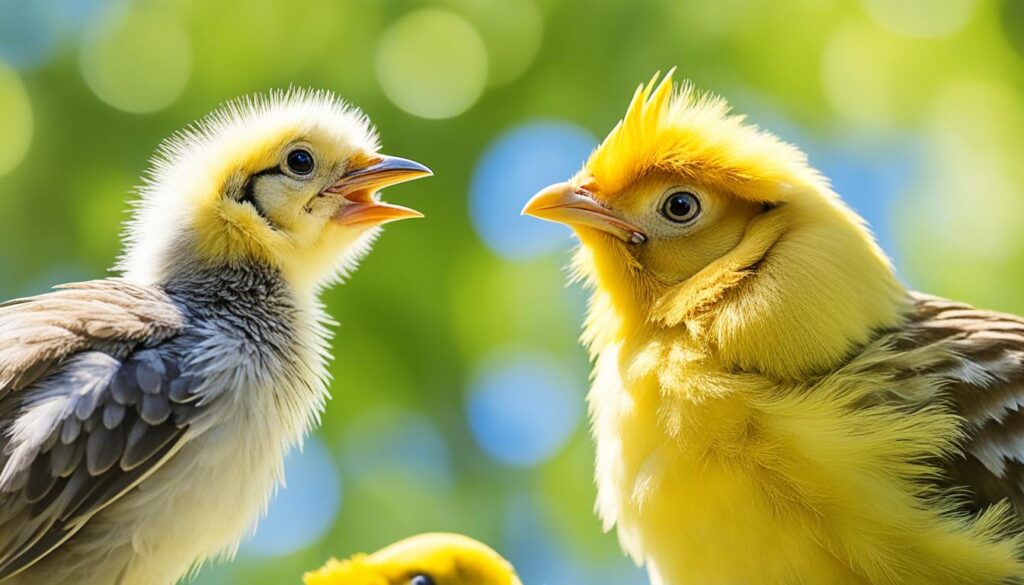There are many words for describing baby birds, just as there are many kinds of birds. You might hear terms like hatchlings and fledglings>. These names show how old the bird is or even what bird type it is. It’s important to know these baby bird names to help any newborn birds you find in nature.
Key Takeaways
- Diverse terminology exists to describe baby birds, including hatchlings, nestlings, and fledglings.
- Specific names for baby birds can vary by species, such as poults for chickens and squabs for doves.
- Understanding avian offspring terminology is important for identifying and caring for newborn birds.
- The evolution of bird terminology has roots in language changes, such as the shift from “fowl” to “chicken” in the 20th century.
- Unique baby bird names often incorporate diminutive suffixes like “-let” and “-ling” to convey smallness and youth.
Introduction to Baby Bird Terminology
The bird world has many terms for baby birds. Baby birds grow and change a lot from birth to when they leave the nest. Knowing these terms helps people who love baby birds or take care of them.
Precocial birds like chickens can stand and walk within an hour of hatching. Altricial birds, on the other hand, are born blind and weak. They need their parents for protection and food. Some special birds, like pigeons, have a special milk for their young.
Altricial birds include many songbirds, corvids, and birds of prey. They are born naked, blind, and small. They grow in warm nests until they can fly on their own. Precocial birds, like ducks or ostriches, are ready to explore from day one. They can see and move well, which helps them find food.
Baby birds, or chicks, have three main stages: hatchling, nestling, and fledgling. Fledglings are almost grown up but still look a bit messy. They may have special features near their mouths. These help their parents know to put food there.
Learning baby bird terms is important for caring for them. By knowing these words, we understand and respect the amazing growth of birds all around us.
General Terms for Baby Birds
There are important words to know about baby birds and their growth. These terms help bird lovers, rescuers, and those curious about birds. They describe the steps from egg to flying.
Clutch
A clutch means all the eggs a bird family is caring for. The number can be from one to over a dozen, depending on the bird. The eggs are kept warm until they’re ready to hatch.
Brood
After eggs hatch, the babies make up a brood. These babies are from the same family and are known as a broodmates. Together, they make a lively bunch in the nest.
Hatchling
A hatchling is a newborn baby bird. They are tiny, with no feathers and their eyes closed. The parents work hard feeding and protecting them.
Nestling
As babies grow, they’re called nestlings. They start getting their first soft feathers. They’re still babies, though, and need their parents to feed and keep them safe.
Fledgling
Just before becoming independent, baby birds are fledglings. They have real flight feathers and can hop around. Even though they leave the nest, parents keep feeding them.
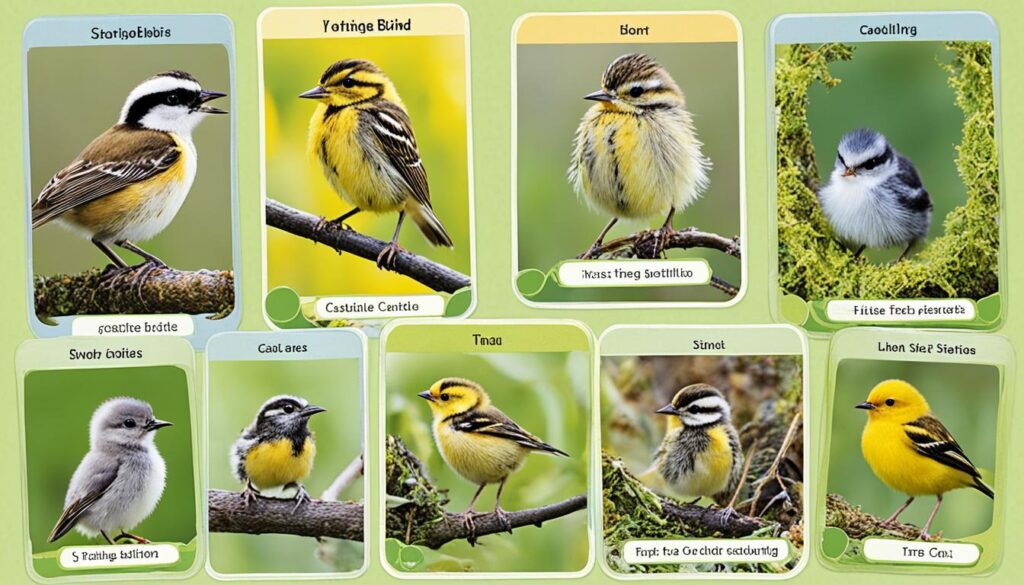
Knowing these terms helps us see the beauty in a baby bird’s journey. We begin to understand and marvel at how young birds become flying adults. It’s a fascinating process to watch.
Species-Specific Baby Bird Names
Many birds have special names for their babies, other than “chick,” “nestling,” or “fledgling.” These unique names show us more about each bird’s traits and habits. We will look at some of these special baby bird names for popular bird species.
Chickens
In the chicken world, a young male is a cockerel. A young hen is called a pullet or poult. These names tell us about the changes in male and female chickens as they grow. This shows their physical and behavioral differences.
Cranes
Young cranes are called colts. These birds are large and move with grace. Their young also have these traits very early on.
Doves
For doves, their young go by some cute names: squabs, squeakers, and squealers. These names come from the sounds young doves make. They are quite noisy when they are in the nest.
“The names of baby birds can reveal a lot about their species’ unique traits and behaviors.”
Learning the special names for baby birds teaches us about nature. It helps us see the huge variety in the bird world. We can understand and admire the different skills and features birds have.
What Are Baby Birds Called?
The world of baby birds is full of interesting terms. From generic names to species-specific ones, there’s a lot to learn. For instance, we may call them hatchlings, nestlings, or fledglings. Or, we might use names like poults, colts, and squabs, depending on the species.
Take songbirds as an example. They go through three key stages of development. First, they are hatchlings, born without feathers and very weak. They stay in the nest without moving much. Next, they become nestlings. They are a bit older, have feathers now, and their eyes are open. But still, they can’t walk or perch well. Finally, we have fledglings. At this stage, they have enough feathers to fly. They are trying to fly and learn to eat on their own.
| Baby Bird Stage | Characteristics |
|---|---|
| Hatchling | Mostly or entirely naked, totally helpless, stay in nest, cannot walk or perch |
| Nestling | Starting to get feathers, eyes open, unable to walk well or perch |
| Fledgling | Feathered, can hop and perch, attempting to fly, learning to eat on their own |
But there’s even more to learn. It gets very specific by species. For instance, baby chickens are chicks. Baby cranes are colts. And baby doves are called squabs. This rich vocabulary shows how much we love and wonder about baby birds.
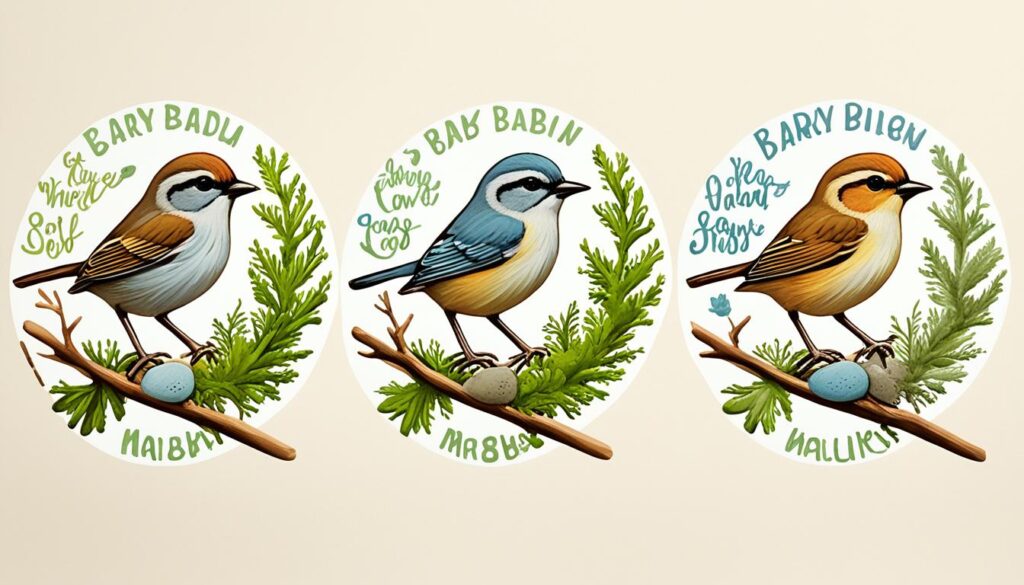
Observing the nest for at least two hours can confirm if the parents are returning to care for the babies in cases of intervention.
Identifying Nestlings and Fledglings
Knowing the difference between baby birds is important when we find them in the wild. It helps us figure out how to help and protect them. This gives them a better shot at surviving.
Nestlings are baby birds that stay in their nest. They don’t have many feathers yet. These baby birds need their parents for everything. Usually, small birds like songbirds start as nestlings.
Fledglings, on the other hand, are ready to leave the nest. They have their flight feathers. They’re not too good at flying yet but can move around. Yet, they still need their parents for food and care.
| Characteristic | Nestling | Fledgling |
|---|---|---|
| Feather Development | Lacking feathers or with only down | Fully feathered |
| Mobility | Dependent, unable to leave the nest | Able to move, hop, walk, and fly short distances |
| Dependence on Parents | Completely dependent on parents for food, warmth, and protection | Dependent on parents for food and care, but more independent |
The type of bird affects how baby birds grow. For example, ducks and geese hatch ready to go. They can walk and find food by themselves.
If you see a baby bird, give it space and watch. Don’t help unless it’s hurt or looks very sick. If you’re not sure, call a local animal rescue for advice.
Getting it right between baby birds is key to their safety. Knowing when to step in and when to let nature be is crucial for their well-being. It gives them the best start for life out in the wild.
Caring for Found Baby Birds
Finding a baby bird in need means checking if it’s a nestling or fledgling. Knowing this helps us provide the right care. Proper care improves their chance of living. Now, let’s look at how to best help these young birds.
Nestlings
Nestlings are very young and can’t fly. If you spot one, your first aim is to return it to the nest. Touching them won’t make their parents stop caring for them. You can safely put them back. But, be careful not to disturb the nest too much. This can scare the parents away.
Fledglings
Fledglings have left the nest but can’t fly well yet. It’s best not to help them. Even if they seem left alone, their parents are likely watching and feeding them. Helping may harm their natural survival skills.
If a baby bird is hurt or in danger, then it’s time to get help. A wildlife rehabilitation center can provide the best care. These professionals know how to best care for injured birds. They aim to release them back into the wild.
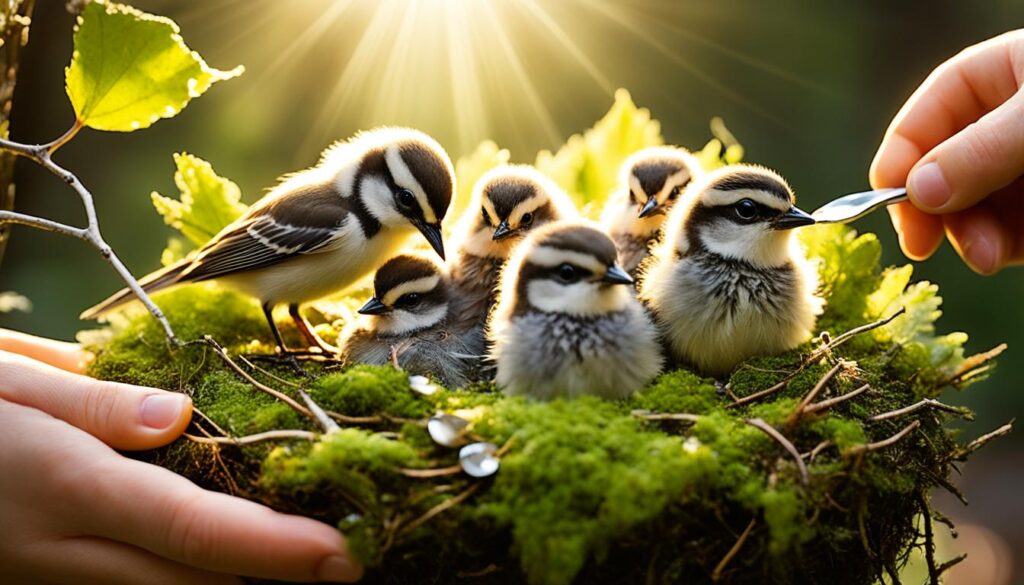
“The best thing to do is leave the baby bird alone and observe from a distance to see if the parents return. If the parents don’t return or the baby is injured, then you should contact a wildlife rehabilitator for assistance.”
Learning how to help nestlings and fledglings is key. Knowing when to act or wait is crucial. By doing our part while keeping nature’s balance, we help these little ones. Remember, always get help if needed for their best chance.
Baby Bird Feeding and Rehabilitation
Caring for a baby bird takes time and effort. It’s best to seek help from a licensed wildlife rehabilitator if you find one. Trying to care for a baby bird alone is hard and often illegal.
Baby birds grow through three phases: hatchling, nestling, and fledgling. Each phase needs different care and feeding methods. This helps them grow into healthy adult birds.
It’s vital to check a baby bird for injuries when you find one. If it’s hurt, like having broken bones, call a wildlife expert right away. Cats can also make baby birds sick, even if they just scratch them.
Feeding baby birds is a detailed task. Altricial birds need feeding every 30 minutes because they can’t get food themselves. You can prepare a mix for them with mynah bird pellets, or you can use dry dog food. Add some baby food, turkey, cooked egg yolk, and water to the mix.
Precocial birds, like ducks and geese, have special needs. These birds shouldn’t swim until they are older. Swimming too early can harm them as they develop.
If you need to move a baby bird, do it with care. It’s often better to let experts handle this. Wildlife rehabilitators can offer advice and help. You can contact the Wildlife Information Center at (203) 544-9913 for further assistance.
Raising a baby bird means giving a lot of your time and knowing what you’re doing. It might seem doable, but it’s better to let professionals take over. They can provide the right care for the baby bird to grow strong and go back to the wild.
Etymology and Origins of Baby Bird Names
The world of baby bird names is fascinating. Words like “duckling” and “eaglet” show how rich and old avian language is. “Eyas,” a term for a young hawk, comes from the French “niais,” linked to falconry.
Ducklings
“Duckling” shows how language can make things sound small or young. The term comes from an old Germanic root that means “small.” This word paints a cute picture of fluffy baby ducks.
Eaglets
The term “eaglet” works much like “duckling.” The “let” on the end shows it’s the young version of the eagle. It highlights how young eagles are small and delicate before growing big and strong.
Eyas
Then there’s “eyas,” direct from French and used in falconry. It means a young hawk taken from the nest. This term is for any young bird of prey captured before it learns to fly.
Knowing where these baby bird names come from adds depth to our understanding. It shows the rich history of these words and the cultures behind them. It gives us a new way to talk about these amazing creatures and their early stages of life.
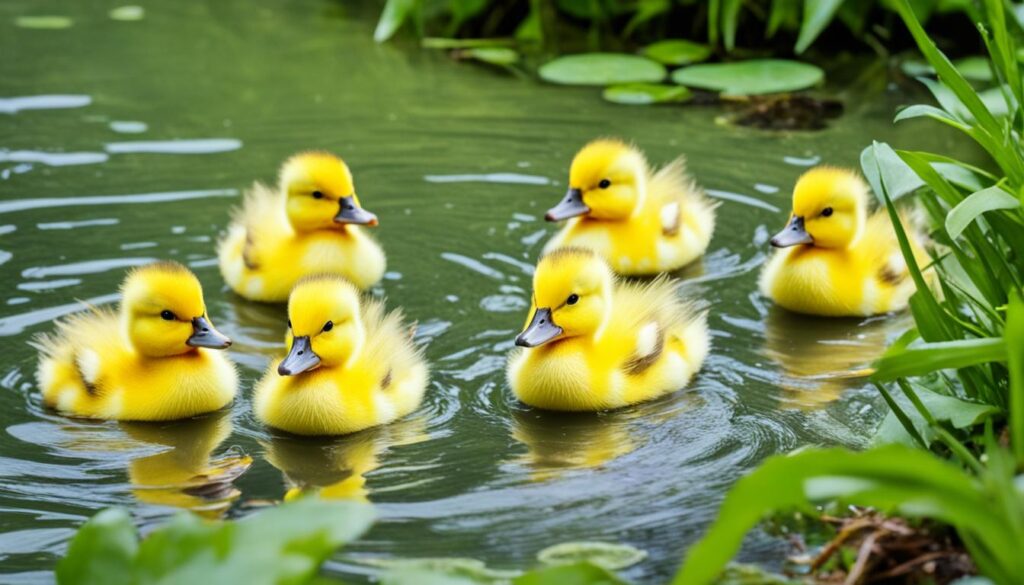
Unique Baby Bird Names by Species
Common names like “chick” and “fledgling” are well-known. But, each bird species has its unique baby term. For example, puffins have “pufflings,” and turkeys have “poults” and “jennies.” These names show the beauty of bird language.
Did you know baby chickens are “poults,” baby cranes are “colts,” and baby doves are “squabs”? This is just the start of a long list of bird life cycle terms.
There are “eaglets” for young eagles and “goslings” for baby geese. We also have “peeps” for sandpipers and “cygnets” for baby swans. These names are unique and enrich our bird knowledge.
Learning these names deepens our connection to nature. It helps us see the amazing variety in our world. By knowing these special names, we value life’s complexity even more.
Whether you love bird watching or just enjoy nature, learning about baby bird names is fun. The next time you see a baby bird, think about the perfect name for it.
From Hatchling to Juvenile: Baby Bird Growth Stages
Baby birds undertake an amazing journey of growth and change. They develop from helpless hatchlings to independent juveniles. Each phase is key for their survival and growing up. Knowing about these stages gives us valuable insight into bird growth.
Newborn birds start as hatchlings. They are fragile, without feathers, and need a lot of care and protection. Their parents give them warmth, food, and keep them safe. As they grow, hatchlings become nestlings. They start showing feathers and can move a bit more in the nest.
The fledgling stage is when things get interesting. Young birds get to check out their environment and try to fly. At first, they might not be great at it. But they improve over time. Then comes the juvenile stage. This is just before they become adults. They keep growing their feathers and skills for survival.
| Growth Stage | Age Range | Key Characteristics |
|---|---|---|
| Hatchling | 0-3 days | Newborn, featherless, and reliant on parental care |
| Nestling | 4-9 days | Developing feathers, increased mobility within the nest |
| Fledgling | 9-14 days | Capable of short flights, exploring their surroundings |
| Juvenile | 14+ days | Continued development of plumage and survival skills |
The timing and features of growth stages can differ between birds. But, the journey from hatchling to juvenile is the same. Learning about these stages can assist bird lovers and those who care for them.
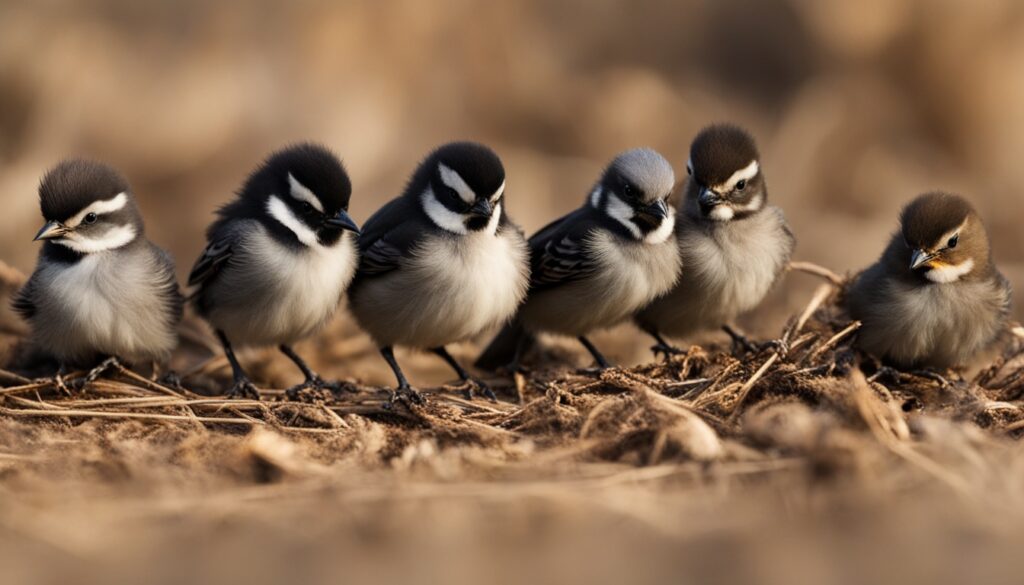
Learning about baby bird growth is fascinating. It reminds us how complex and varied bird life is. Every step from hatchling to juvenile brings the bird closer to adulthood. This marks another success in the bird species’ continuation.
Fascinating Facts About Baby Birds
Baby birds are incredible creatures. They show off unique traits and actions. These capture the hearts of nature lovers. We can learn a lot from their quick growth to marvelous flying abilities.
Baby birds have interesting ways of feeding. For example, Northern Goshawks airdrop food to their chicks. This is a special feeding method. And Common Loons guard and care for their young closely. This shows how some birds look after their offspring.
Some bird species have a special rule between the males and females. In some cases, like with Black-backed Woodpeckers, males do most of the work in nesting. This is an extraordinary role that the males play. Birds like Canada Jays even use their wings and tail to make an “umbrella” for their babies in bad weather. This is a smart way they protect their young.
Young birds have their own sets of troubles. Bicknell’s Thrushes are called altricial birds. It means they are born without the ability to do much. They rely heavily on their parents’ care. This highlights how delicate some bird species are when they are young.
- Juvenile birds leave the nest at different ages, from 12 to 21 days old, depending on their type.
- Though their bones are like adult birds, they are still growing.
- Juvenile birds have shorter wings and often land clumsily.
- They look different from adult birds, often helping them hide better.
- They might scoot or perch in bushes since they can’t fly well early on.
- Even after leaving the nest, the parents continue to watch over their young.
As baby birds grow up, they change in amazing ways. In just a month, they get better at flying and looking. Their feathers transform from simple and light to eye-catching and dynamic. This process is incredibly interesting to watch.
From how Northern Goshawks feed to Canada Jays’ clever tricks, baby birds bring us joy. Their lives are full of unbelievable stories. Knowing these facts lets us see the beauty and variety in the bird world.
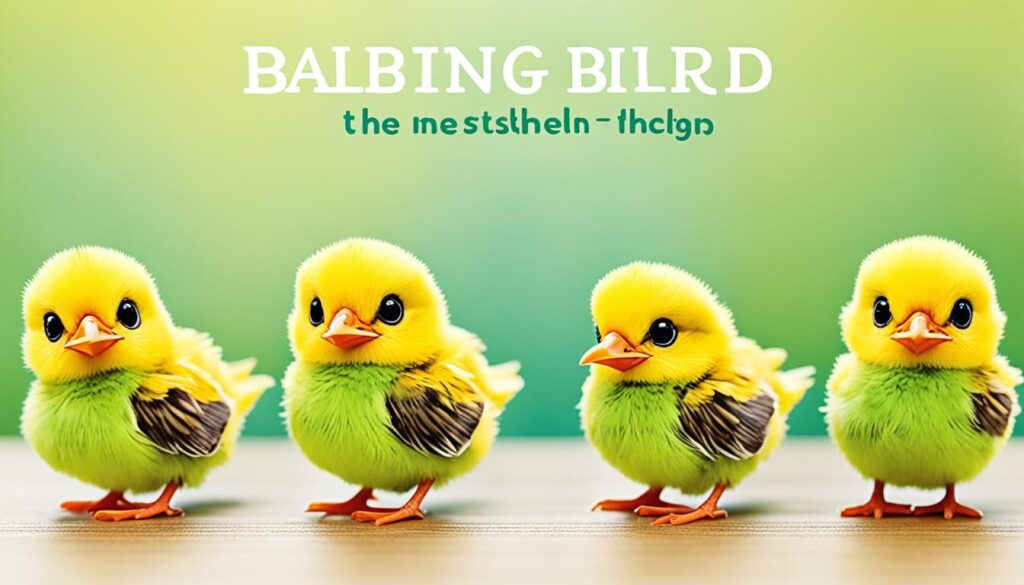
Conclusion
The words we use for baby birds show how interesting they are. Words like hatchlings and fledglings are just the start. There are even names that depend on the bird type. Knowing these terms helps us take care of baby birds we find in the wild. We can learn a lot about baby birds’ growth and what makes each type special.
Eggs from birds are strong and protect what’s inside. Some birds are very careful when they build their nests. For example, sociable weavers build nests together. Others, like brood parasites, trick different birds into raising their young. There’s always something interesting to learn about how baby birds live. Knowing about caring for baby birds and facts about baby birds helps us protect them and help them survive.
The bird world is full of amazing things to learn and see, especially about baby birds. Knowing the correct terms can be helpful for anyone interested. With this knowledge, we can connect more with nature. We can also help protect these awesome birds for the future.
FAQ
What are the general terms used to describe baby birds?
Different terms are used for baby birds at each stage of their growth. For example:
– Clutch is a group of eggs that will hatch.
– A brood is a group of babies from the same parents.
– Hatchlings are just born, they don’t have feathers yet.
– Nestlings are a few days old, growing their first feathers.
– Fledglings have flight feathers but still rely on their parents before fully leaving the nest.
What are some species-specific names for baby birds?
Every bird has its own special name for the young. For instance:
– Baby chickens have names depending on sex. They might be cockerels, pullets, or poults.
– Colt is what you call a baby crane.
– Young doves are squabs, squeakers, or squealers. This is because they chirp a lot when young.
How can you identify a nestling versus a fledgling?
It’s pretty easy to tell if a baby bird has left the nest or not. Nestlings are still in the nest. They don’t have many feathers, maybe just some down.
Fledglings, however, have lots of feathers. They are trying out their wings but still need their parents.
How should you care for a found baby bird?
If you find a baby bird, make sure you know if it’s a nestling or a fledgling. If it’s a nestling, put it back in the nest so its parents can look after it. Nestlings cannot fly yet.
If it’s a fledgling, leave it where you found it. They are learning to fly. Their parents are close by and take care of them. Only help if they’re in danger or hurt.
What are some unique and interesting facts about baby bird names and terminology?
Baby bird names have fun and interesting origins. The “-ling” in words like “duckling” shows small size. “Eyas” comes from a French word for falcon or hawk chick.
There are many special baby bird names too. For turkeys, they are “poults” and “jennies”, while puffins’ babies are called “pufflings”. These names show the rich language of bird naming.
